Timber’s Natural Insulation Properties and its Full Potential
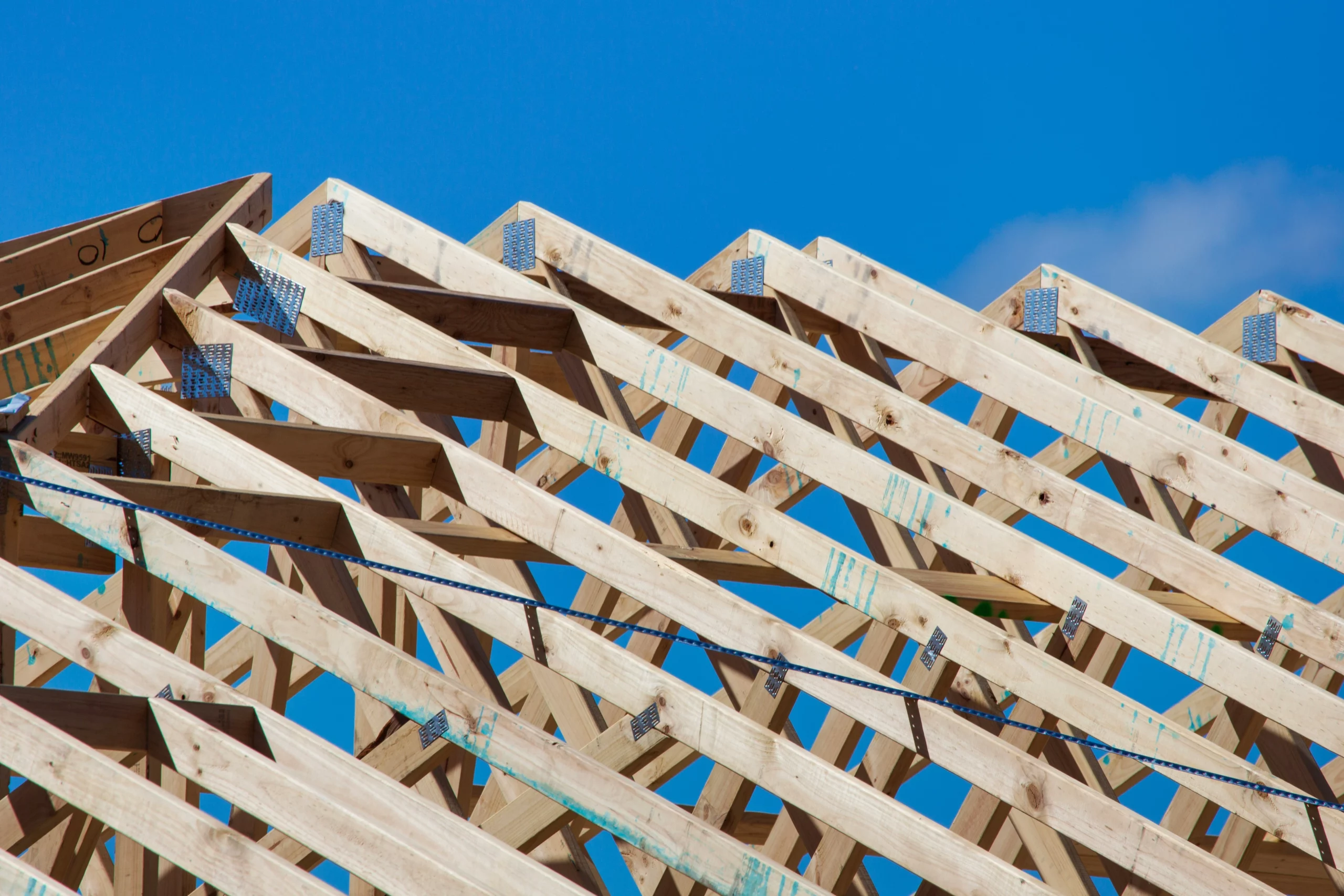
Image from Unsplash
For many years, Scotland’s most popular building material has been timber frame, accounting for about 83% of newly constructed homes. With so many homes being constructed to Passivhaus standards, its advantages in terms of energy efficiency, sustainability, and thermal performance are well known and now more significant than ever.
Timber frame homes are even more environmentally friendly when they are paired with natural insulating materials. It indicates that while maintaining a cozy and healthful living space, the building can achieve notable reductions in both embodied carbon and energy use.
So, what exactly is natural insulation?
Natural insulation is made from renewable resources including jute, hemp, sheep’s wool, and wood fibers. Compared to more traditional insulation choices like mineral wool or foam, they have a higher sequestered biogenic carbon content and a substantially less carbon footprint. Timber frame houses can be made even more sustainable by using natural insulation.
Natural wood fiber insulation offers high levels of thermal insulation, greatly lowering heat absorption in the summer and heat loss in the winter. One example of this is Gutex Multitherm, an insulated sarking board created from recycled wood chips. Many people understand the advantages of less energy used for heating and cooling, cheaper utility costs, and cozier living quarters.
Why is timber such a good insulator?
The cellular structure of wood is one of the factors that makes it such a successful insulator. Tiny air pockets found in wood trap heat and slow down heat transport, which lowers thermal conductivity. Wood has a lower thermal diffusivity score than other building materials because of this.
A material’s ability to keep heat from escaping can be measured scientifically using its thermal diffusivity. The building’s ability to maintain a more steady internal temperature is indicated by a lower score.
1- Timber controls humidity
In addition to its sustainable performance and energy-efficiency, natural insulation materials in timber frame construction also aid in preventing condensation problems inside the building. This is due to the fact that breathability (low moisture vapour diffusion resistance) and high moisture absorption/desorption properties are two of the primary attributes of natural insulating materials.
Natural insulation permits water vapor to travel through the walls, in contrast to synthetic insulation, which can trap moisture and cause condensation problems. As a result, there is less chance of interstitial condensation, mold, rot, and other moisture-related issues within the building envelope. It also helps to keep the interior air quality good by letting moisture from routine tasks like cooking and taking a bath leave the building.
The demand for wood fiber insulation has increased in recent years as a result of specifiers realizing its benefits over synthetic materials in terms of both environmental qualities and technological advantages. Because wood fiber insulation absorbs excess heat and reduces temperature spikes within the building, it has been found to be useful in preventing overheating. Wood fiber insulation also helps to keep an interior temperature that is comfortable by gradually releasing heat that has been stored during cooler weather.
Gutex, which was founded more than 80 years ago, was among the first to develop a method for producing insulated dry wood fiber boards. To further illustrate its commitment to the environment and healthy living, Gutex has obtained EPDs (Environmental Product Declarations) for its whole product line and is natureplus certified.
2- A lot of timbers can withstand decay
Not only is wood a fantastic insulator in warm areas. It can help businesses and households overcome additional difficulties.
For instance, a lot of wood species have a built-in resistance to insect damage and decay, which makes them a long-lasting and robust material for shielding buildings from the weather. The purpose of the timber durability classes is to rank each type of wood according to its level of durability, with Class 1 being the highest and Class 4 being the lowest.
3- Timber cladding is a natural insulator
Goods like external vertical timber cladding act as a natural insulating barrier to assist control the building’s interior temperature. This implies that it can aid in keeping the building cool during the sweltering summer, lessening the need for air conditioning and contributing to energy savings. Because of their inherent insulating qualities, wood products like timber cladding and insulator wood are becoming more and more in demand during these energy-conscious times.
 Timber construction is the way forward in terms of sustainability. It offers a renewable, low-carbon alternative to traditional building materials, with the added benefit of enhancing the aesthetic appeal of structures. - Alex de Rijke, Founding Director at dRMM Architects
Timber construction is the way forward in terms of sustainability. It offers a renewable, low-carbon alternative to traditional building materials, with the added benefit of enhancing the aesthetic appeal of structures. - Alex de Rijke, Founding Director at dRMM Architects
The 2050 Materials team worked on a full cladding specification handbook which you can preview below (in low resolution) and have access to the high resolution version here.

Cladding Handbook brought to you by 2050 Materials
Natural insulation alternatives
Below are some alternatives for natural insulation and some information on each:
Wood fiber boards
Timber from forests that are responsibly managed is used to make premium wood fiber insulation boards. The chips and shavings are a by-product of the trees being used for other purposes; they come from untreated spruce.
Gutex wood fiber boards reduce heat loss and sound transmission because of their superior thermal and acoustic insulation qualities. Furthermore, they are vapour-permeable, which lets air into the timber frame structure and keeps moisture from building up. Additionally, the boards are windtight, preventing wind washing from damaging the insulation behind the boards between the timber and minimizing thermal by-pass. Thermal bridging is also greatly decreased by encircling the external wall and roof timbers with Gutex Wood fibre insulation boards.
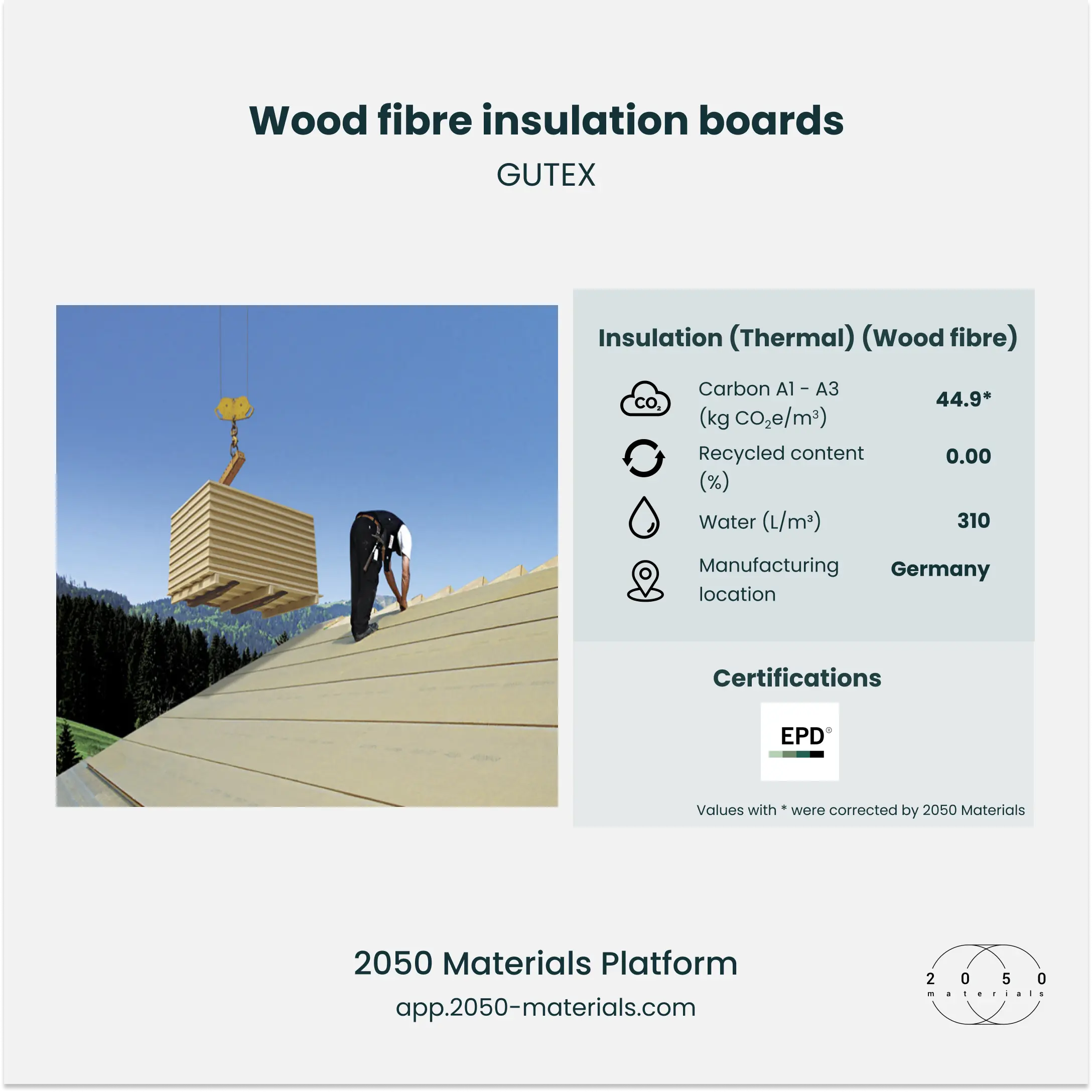
Gutex Wood fibre insulation boards on 2050 Materials platform
Thermo Hemp Combi Jute
Repurposed jute fibers and hemp are combined to create an innovative insulation material. This natural insulating material has exceptional sound-absorbing and heating capabilities. Its thoughtful design as a permeable material guarantees moisture control in the construction of the timber frame.
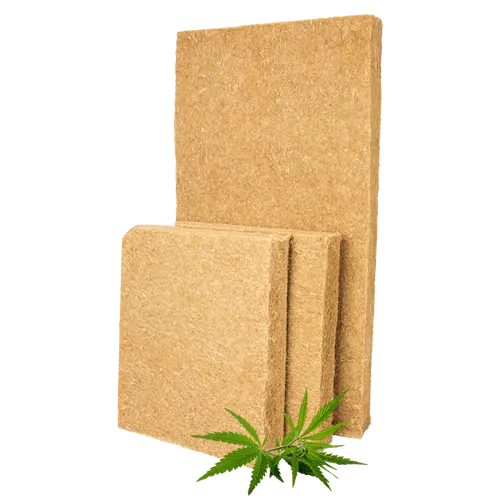
Thermo Hemp Combi Jute Insulation mats on 2050 Materials Platform
Gutex Thermoflex
Made from recycled wood chips, Gutex Thermoflex is a high-performance, simple-to-install flexible wood fiber insulation. Thermoflex comes in 1,350 mm long mats, or batts, and offers excellent thermal insulation in the winter and greatly lowers the chance of overheating in the summer. It is simple to friction fit the Gutex Thermoflex between timbers. Because of the product’s great breathability, humidity and moisture control within the structure may be maintained year-round.
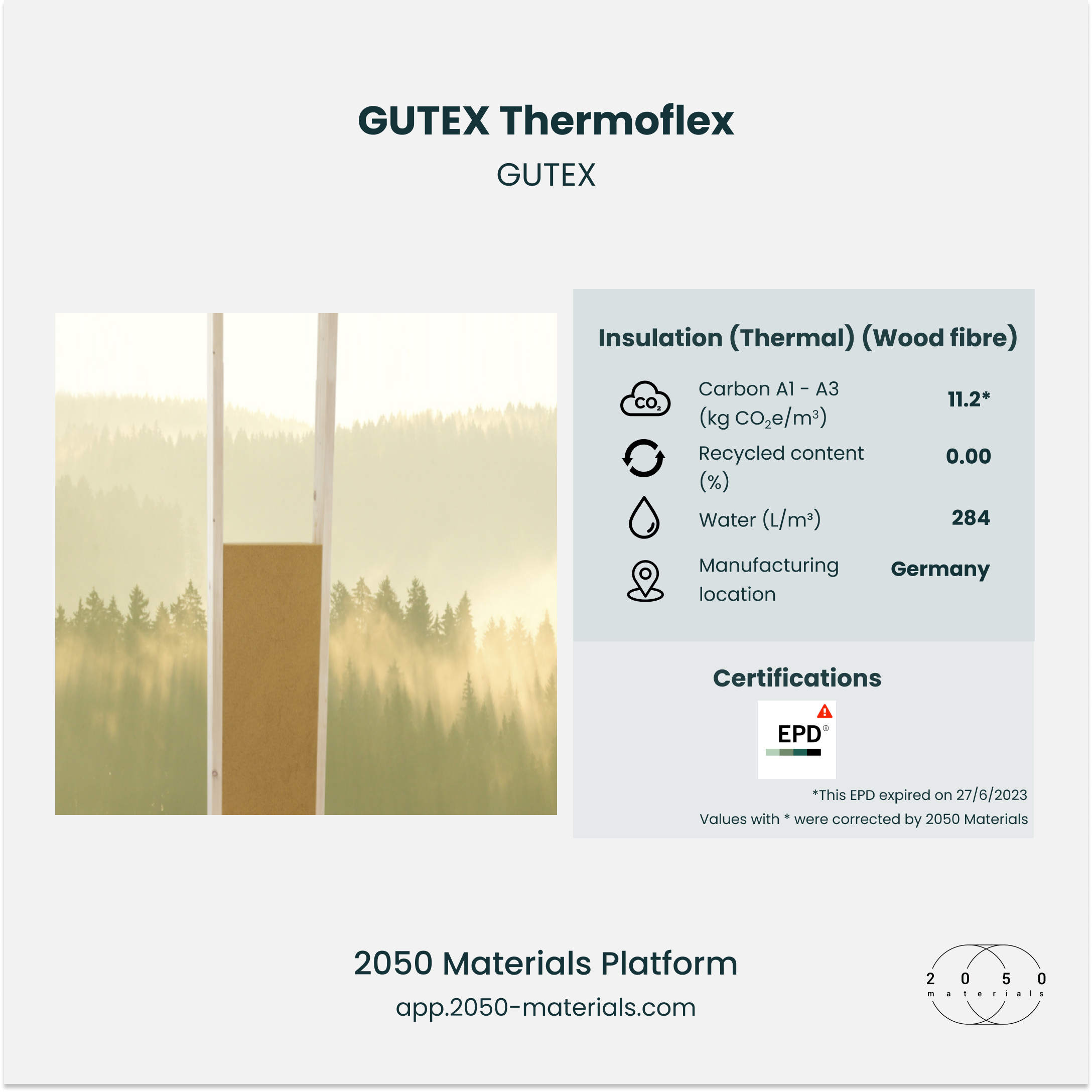
Gutex Thermoflex on 2050 Materials Platform
Gutex Thermofibre
A loose-fill fiber insulation material with a high concentration of sequestered biogenic carbon that may be blown into enclosed spaces in wood frame wall, roof, floor, and ceiling systems. As a loose covering of wood fiber blown over the ceiling joists, it is perfect for usage in lofts. Additionally, it is especially helpful for insulating I beams, posi-joists, and twin stud systems, where it would be challenging to obtain a full-fill through the placement of insulation quilts or batts. Excellent continuous insulation without air gaps between the insulation, wood, or metal frame parts can be achieved with fibrous insulation, such as Thermofibre. It is also possible to completely enclose, without any gaps, services such as cables, pipelines, and odd shapes.

Gutex Thermofibre on 2050 Materials Platform
Passivhaus building
Natural insulating materials are a good option for Passivhaus projects since they assist buildings achieve high energy efficiency levels while keeping the interior atmosphere healthy. In addition to moisture control within a timber frame building, many Passivhaus projects use natural wood fiber boards and airtight racking systems to provide optimal thermal efficiency.
More on passivehaus building and design in this interesting article.
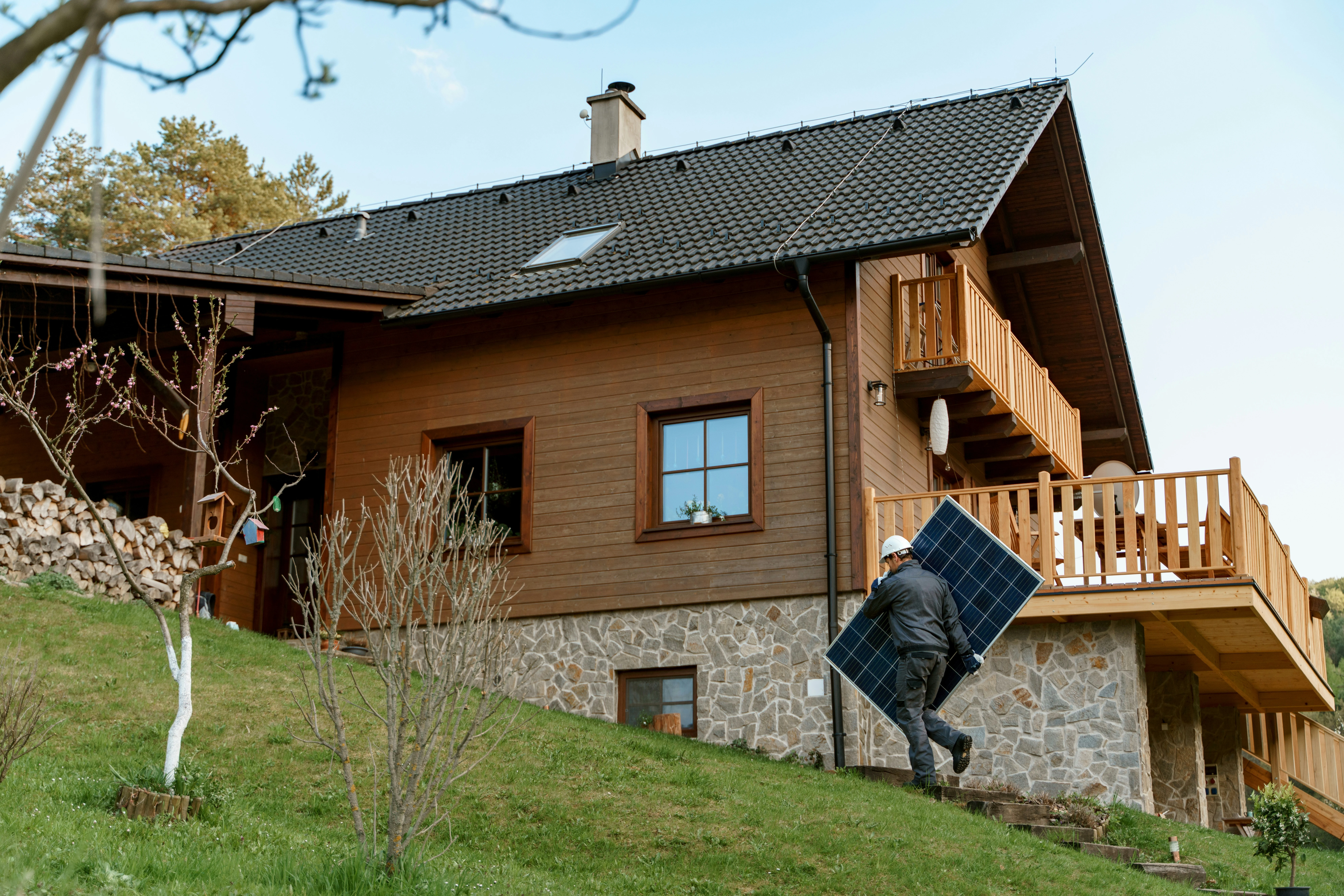
Image from Unsplash
Setting up
Like all insulation materials, proper installation of natural insulation is crucial. This entails utilizing the proper tapes and sealants, sealing joints, and seamlessly integrating insulation into the building envelope to ensure airtightness. To avoid any future problems, it’s also critical to take into account how certain materials interact with moisture and how compatible they are.
 Timber: An environmentally friendly, renewable, and energy-efficient fix
Timber: An environmentally friendly, renewable, and energy-efficient fix
Building ecologically conscious homes can be made more sustainable, energy-efficient, and aesthetically pleasing by combining natural insulating materials with timber frame construction. Within the timber frame structure, superior thermal performance, breathability, and moisture management are achieved through the use of natural wood fiber boards and flexible insulation.
Utilizing the innate qualities of natural insulation, timber frame structures can be designed to use less energy and contribute to a healthier and greener future.
Sources:
Harnessing the power of natural insulation — Project Scotland
Why Is Wood A Good Insulator? | The Ideal Solution To The Australian Climate — Mortlock Timber
Related articles

Climate-Resilient Materials for the Built Environment: A Data-Centred Prime
As climate volatility intensifies, resilience metrics are fast becoming as critical as carbon data in material selection. This article outlines why adaptation is now a design imperative, how materials can be evaluated through a systems lens, and what KPIs project teams should demand. From self-healing concrete to fire-rated façades, we present a structured taxonomy of resilient materials, explain how to embed this intelligence into digital design workflows, and propose next steps for specification, benchmarking, and procurement.
Read more
The Most Interesting Low Carbon Products in Office Design
In this article and collection, we highlight 11 outstanding products that contribute to a lower carbon footprint in office design.
Read more
Top Low Carbon Building Boards: Performance, Benefits, and Use Cases
The building boards highlighted in this article and collection showcase low-carbon innovation in modern construction.
Read more